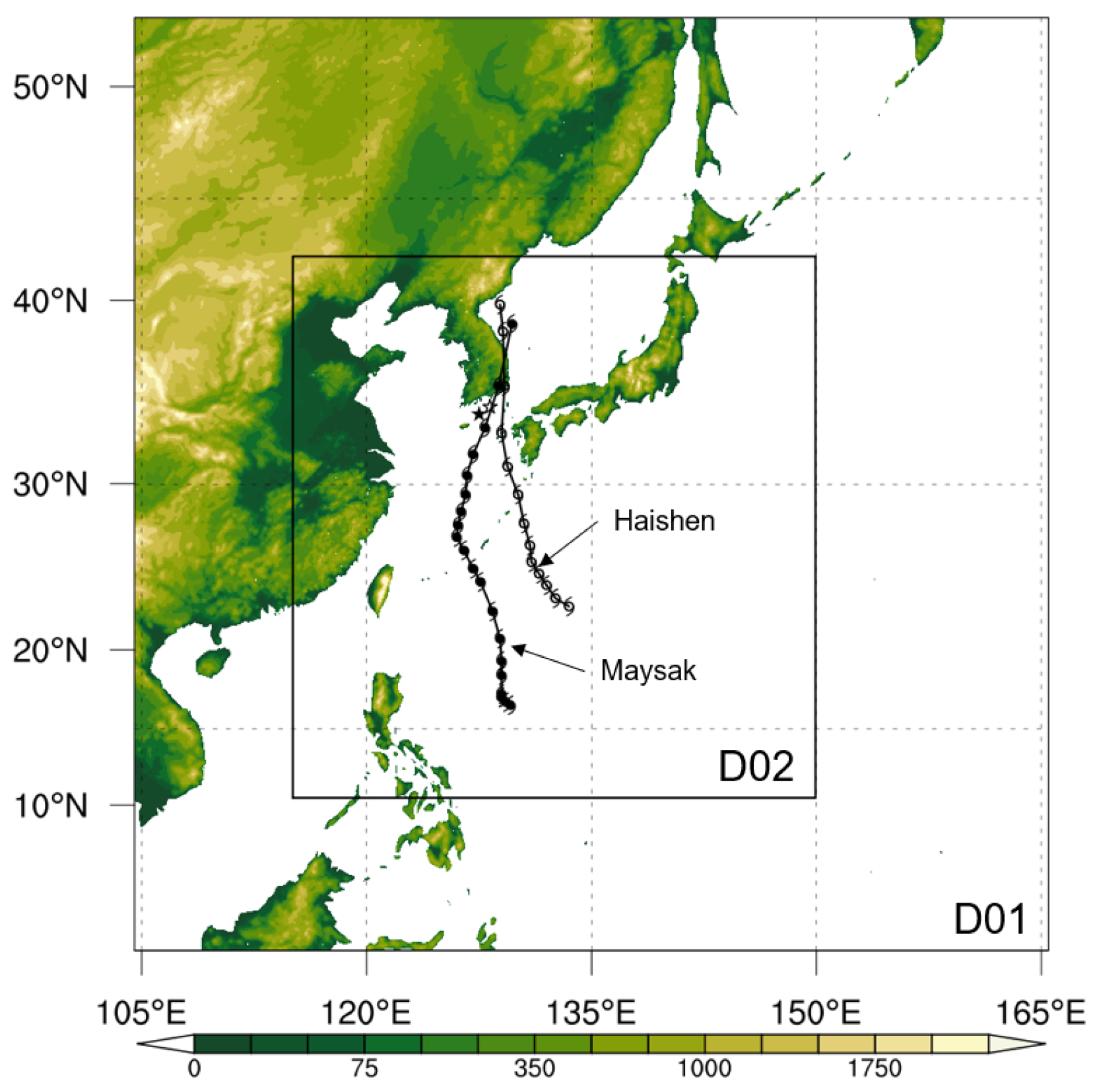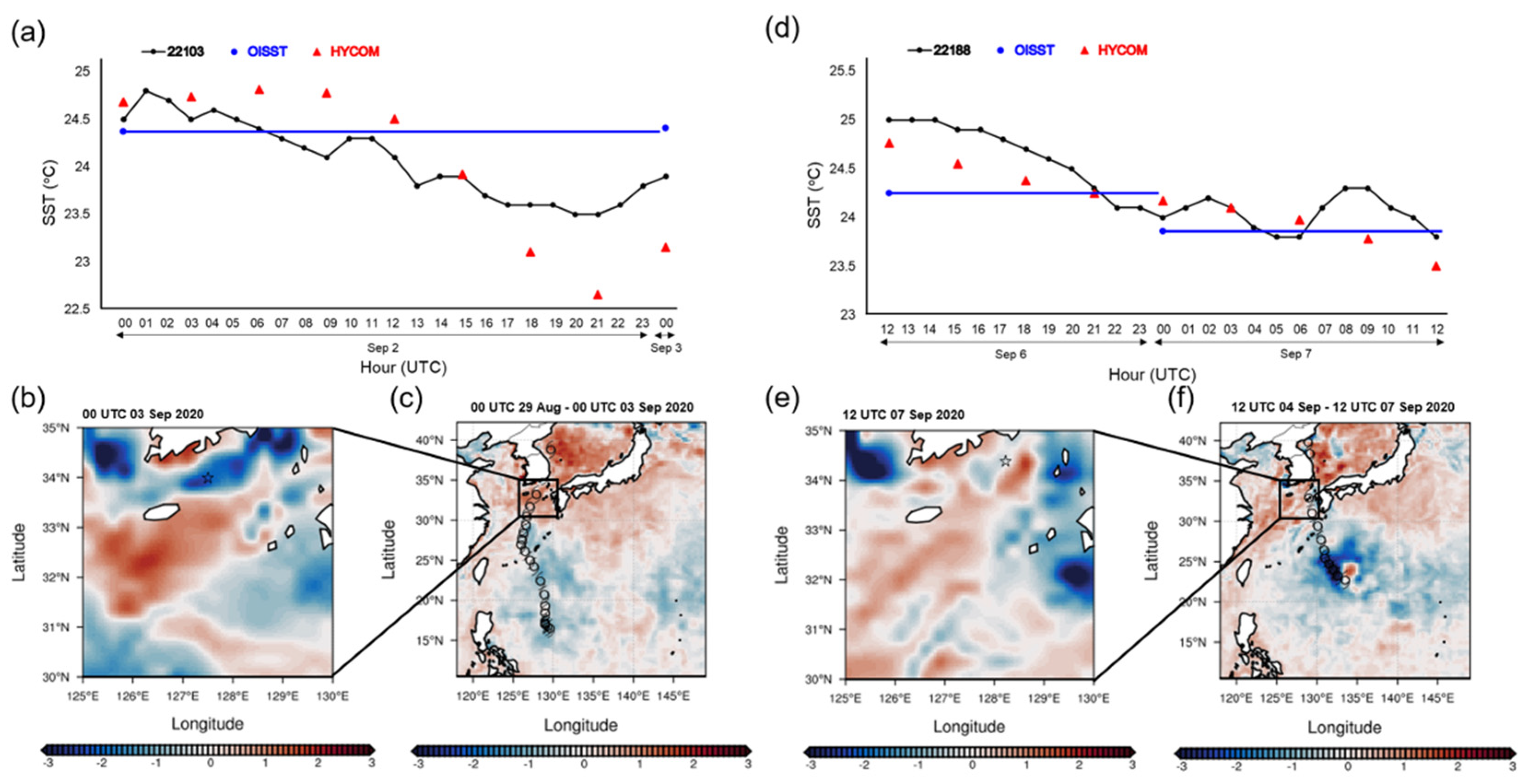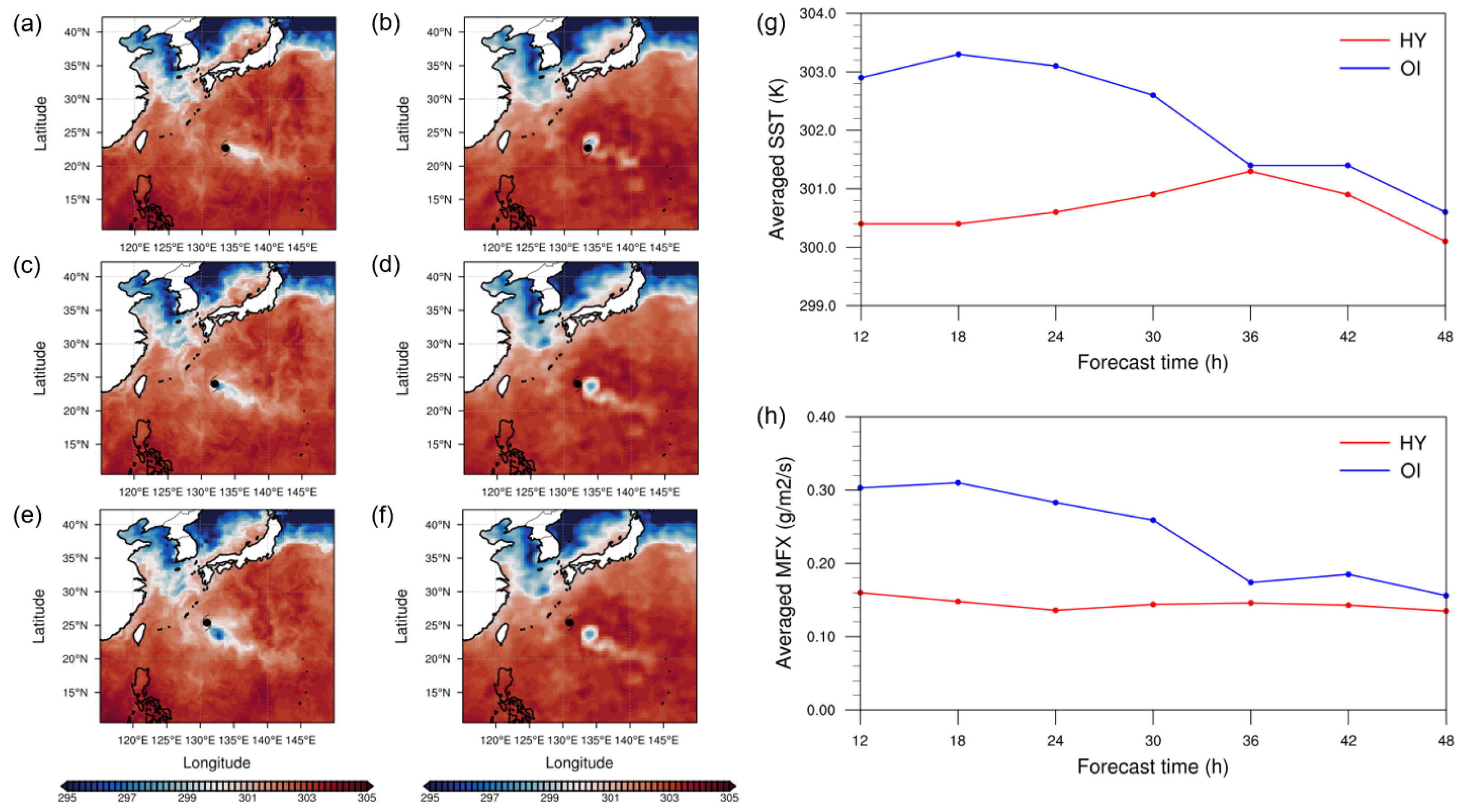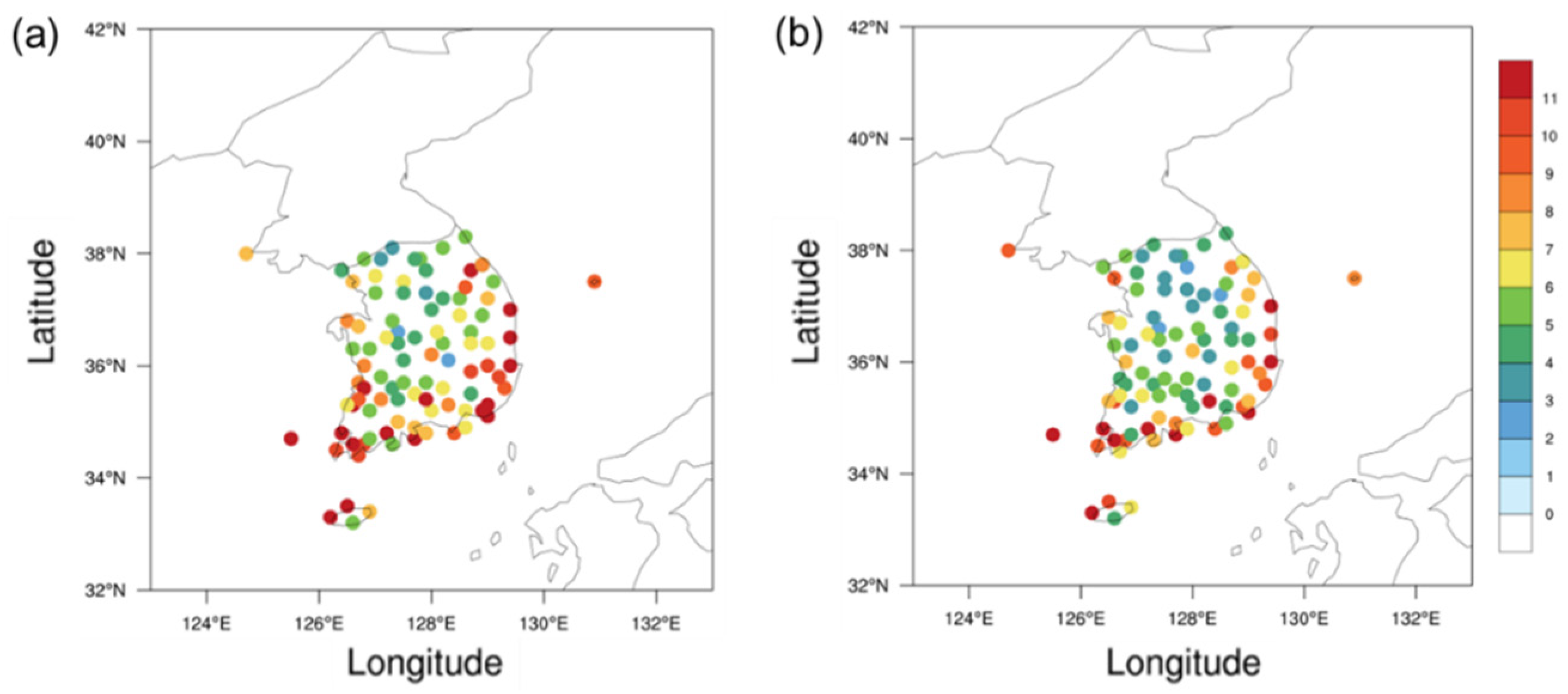Sensitivity of Typhoon Forecast to Prescribed Sea Surface Temperature Data
Abstract
1. Introduction
2. Model Configuration and Experimental Design
3. Results
4. Summary and Conclusions
Author Contributions
Funding
Institutional Review Board Statement
Informed Consent Statement
Data Availability Statement
Conflicts of Interest
References
- Needham, H.F.; Keim, B.D.; Sathiaraj, D. A review of tropical cyclone-generated storm surges: Global data sources, observations, and impacts. Rev. Geophys. 2015, 53, 545–591. [Google Scholar] [CrossRef]
- Peduzzi, P.; Chatenoux, B.; Dao, H.; De Bono, A.; Herold, C.; Kossin, J.; Mouton, F.; Nordbeck, O. Global trends in tropical cyclone risk. Nat. Clim. Change 2012, 2, 289–294. [Google Scholar] [CrossRef]
- Weinkle, J.; Landsea, C.; Collins, D.; Musulin, R.; Crompton, R.P.; Klotzbach, P.J.; Pielke, R. Normalized hurricane damage in the continental United States 1900–2017. Nat. Sustain. 2018, 1, 808–813. [Google Scholar] [CrossRef]
- Emanuel, K. Increasing destructiveness of tropical cyclones over the past 30 years. Nature 2005, 436, 686–688. [Google Scholar] [CrossRef] [PubMed]
- Kossin, J.P. A global slowdown of tropical-cyclone translation speed. Nature 2018, 558, 104–107. [Google Scholar] [CrossRef]
- Webster, P.J.; Holland, G.J.; Curry, J.A.; Chang, H.-R. Changes in tropical cyclone number, duration, and intensity in a warming environment. Science 2005, 309, 1844–1846. [Google Scholar] [CrossRef]
- Chen, T.; Chen, S.; Zhou, M.; Tu, C.; Zhang, A.; Chen, Y.; Li, W. Northward Shift in Landfall Locations of Tropical Cyclones over the Western North Pacific during the Last Four Decades. Adv. Atmos. Sci. 2022, 39, 304–319. [Google Scholar] [CrossRef]
- Kossin, J.P.; Emanuel, K.A.; Vecchi, G.A. The poleward migration of the location of tropical cyclone maximum intensity. Nature 2014, 509, 349–352. [Google Scholar] [CrossRef]
- Studholme, J.; Fedorov, A.V.; Gulev, S.K.; Emanuel, K.; Hodges, K. Poleward expansion of tropical cyclone latitudes in warming climates. Nat. Geosci. 2022, 15, 14–28. [Google Scholar] [CrossRef]
- Chen, G.; Zhang, X.; Bai, L.; Wan, R. Verification of tropical cyclone operational forecast in 2018. In Proceedings of the ESCAP/WMO Typhoon Committee, Guangzhou, China, 26 February–1 March 2019; p. 26. [Google Scholar]
- Morgan, S.T.; Pu, Z.; Westrelin, S.; Yamaguchi, M. SIXTH INTERNATIONAL WORKSHOP on TROPICAL CYCLONES, November 2006. Available online: https://severeweather.wmo.int/iwtc/document/Topic_3_3_Chun_Chieh_Wu.pdf (accessed on 15 October 2022).
- Cangialosi, J.P.; Blake, E.; DeMaria, M.; Penny, A.; Latto, A.; Rappaport, E.; Tallapragada, V. Recent progress in tropical cyclone intensity forecasting at the National Hurricane Center. Weather. Forecast. 2020, 35, 1913–1922. [Google Scholar] [CrossRef]
- Chen, H.; Zhang, D.-L.; Carton, J.; Atlas, R. On the rapid intensification of Hurricane Wilma (2005). Part I: Model prediction and structural changes. Weather. Forecast. 2011, 26, 885–901. [Google Scholar] [CrossRef]
- Mohanty, U.; Osuri, K.K.; Tallapragada, V.; Marks, F.D.; Pattanayak, S.; Mohapatra, M.; Rathore, L.; Gopalakrishnan, S.; Niyogi, D. A great escape from the Bay of Bengal “super sapphire–Phailin” tropical cyclone: A case of improved weather forecast and societal response for disaster mitigation. Earth Interact. 2015, 19, 1–11. [Google Scholar] [CrossRef]
- Srinivas, C.; Bhaskar Rao, D.; Yesubabu, V.; Baskaran, R.; Venkatraman, B. Tropical cyclone predictions over the Bay of Bengal using the high-resolution Advanced Research Weather Research and Forecasting (ARW) model. Q. J. R. Meteorol. Soc. 2013, 139, 1810–1825. [Google Scholar] [CrossRef]
- Brand, S. The effects on a tropical cyclone of cooler surface waters due to upwelling and mixing produced by a prior tropical cyclone. J. Appl. Meteorol. Climatol. 1971, 10, 865–874. [Google Scholar] [CrossRef]
- Wada, A.; Niino, H.; Nakano, H. Roles of vertical turbulent mixing in the ocean response to Typhoon Rex (1998). J. Oceanogr. 2009, 65, 373–396. [Google Scholar] [CrossRef]
- Chiang, T.-L.; Wu, C.-R.; Oey, L.-Y. Typhoon Kai-Tak: An ocean’s perfect storm. J. Phys. Oceanogr. 2011, 41, 221–233. [Google Scholar] [CrossRef]
- Bender, M.A.; Ginis, I.; Kurihara, Y. Numerical simulations of tropical cyclone-ocean interaction with a high-resolution coupled model. J. Geophys. Res. Atmos. 1993, 98, 23245–23263. [Google Scholar] [CrossRef]
- Chan, J.C.; Duan, Y.; Shay, L.K. Tropical cyclone intensity change from a simple ocean–atmosphere coupled model. J. Atmos. Sci. 2001, 58, 154–172. [Google Scholar] [CrossRef]
- Schade, L.R.; Emanuel, K.A. The ocean’s effect on the intensity of tropical cyclones: Results from a simple coupled atmosphere–ocean model. J. Atmos. Sci. 1999, 56, 642–651. [Google Scholar] [CrossRef]
- Kain, J.S. The Kain–Fritsch convective parameterization: An update. J. Appl. Meteorol. 2004, 43, 170–181. [Google Scholar] [CrossRef]
- Hong, S.-Y.; Lim, J.-O.J. The WRF single-moment 6-class microphysics scheme (WSM6). Asia-Pac. J. Atmos. Sci. 2006, 42, 129–151. [Google Scholar]
- Hong, S.-Y.; Noh, Y.; Dudhia, J. A new vertical diffusion package with an explicit treatment of entrainment processes. Mon. Weather. Rev. 2006, 134, 2318–2341. [Google Scholar] [CrossRef]
- Noh, Y.; Cheon, W.; Hong, S.; Raasch, S. Improvement of the K-profile model for the planetary boundary layer based on large eddy simulation data. Bound. -Layer Meteorol. 2003, 107, 401–427. [Google Scholar] [CrossRef]
- Mlawer, E.J.; Taubman, S.J.; Brown, P.D.; Iacono, M.J.; Clough, S.A. Radiative transfer for inhomogeneous atmospheres: RRTM, a validated correlated-k model for the longwave. J. Geophys. Res. Atmos. 1997, 102, 16663–16682. [Google Scholar] [CrossRef]
- Dudhia, J. A nonhydrostatic version of the Penn State–NCAR mesoscale model: Validation tests and simulation of an Atlantic cyclone and cold front. Mon. Weather. Rev. 1993, 121, 1493–1513. [Google Scholar] [CrossRef]
- Bae, S.Y.; Hong, S.-Y.; Lim, K.-S.S. Coupling WRF double-moment 6-class microphysics schemes to RRTMG radiation scheme in weather research forecasting model. Adv. Meteorol. 2016, 2016, 5070154. [Google Scholar] [CrossRef]
- Lee, J.-B.; Lee, D.-K. Impact of cumulus parameterization schemes with different horizontal grid sizes on prediction of heavy rainfall. Atmosphere 2011, 21, 391–404. [Google Scholar]
- Lee, J.-W.; Hong, S.-Y. A numerical simulation study of orographic effects for a heavy rainfall event over Korea using the WRF model. Atmosphere 2006, 16, 319–332. [Google Scholar]
- Reynolds, R.W.; Smith, T.M.; Liu, C.; Chelton, D.B.; Casey, K.S.; Schlax, M.G. Daily high-resolution-blended analyses for sea surface temperature. J. Clim. 2007, 20, 5473–5496. [Google Scholar] [CrossRef]
- Chassignet, E.P.; Hurlburt, H.E.; Smedstad, O.M.; Halliwell, G.R.; Hogan, P.J.; Wallcraft, A.J.; Baraille, R.; Bleck, R. The HYCOM (hybrid coordinate ocean model) data assimilative system. J. Mar. Syst. 2007, 65, 60–83. [Google Scholar] [CrossRef]
- Chelton, D.B.; Wentz, F.J. Global microwave satellite observations of sea surface temperature for numerical weather prediction and climate research. Bull. Am. Meteorol. Soc. 2005, 86, 1097–1116. [Google Scholar] [CrossRef]
- Bongirwar, V.; Rakesh, V.; Kishtawal, C.; Joshi, P. Impact of satellite observed microwave SST on the simulation of tropical cyclones. Nat. Hazards 2011, 58, 929–944. [Google Scholar] [CrossRef]
- Liu, X.; Wei, J.; Zhang, D.L.; Miller, W. Parameterizing sea surface temperature cooling induced by tropical cyclones: 1. Theory and an application to Typhoon Matsa (2005). J. Geophys. Res. Ocean. 2019, 124, 1215–1231. [Google Scholar] [CrossRef]
- Fujiwara, K.; Kawamura, R. Active role of sea surface temperature changes over the Kuroshio in the development of distant tropical cyclones in boreal fall. J. Geophys. Res. Atmos. 2021, 126, e2021JD035056. [Google Scholar] [CrossRef]
- Kim, D.; Kim, H.-S. Relationship between the Tropical Sea Surface Temperature Distribution and Initiation Timing of the Typhoon Season in the Northwestern Pacific. J. Clim. Change Res. 2017, 8, 11–19. [Google Scholar] [CrossRef]
- Setiawan, R.Y.; Susanto, R.D.; Wirasatriya, A.; Alifdini, I.; Puryajati, A.D.; Maslukah, L.; Nurdin, N. Impacts of tropical cyclone Seroja on the phytoplankton chlorophyll-a and sea surface temperature in the Savu Sea, Indonesia. IEEE Access 2021, 9, 152938–152944. [Google Scholar] [CrossRef]
- Yu, S.; Subrahmanyam, M. Typhoon-Induced SST Cooling and Rainfall Variations: The Case of Typhoon CHAN-HOM and Nangka. Open Access Libr. J. 2017, 4, 1–12. [Google Scholar] [CrossRef]






| Version | WRF V4.1.2 | |
| Domains | D01 | D02 |
| Horizontal Resolution | 12 km | 4 km |
| Grids (west-east × south-north) | 491 × 501 | 841 × 871 |
| Microphysics scheme | WSM6 | |
| Cumulus scheme | KF | X |
| PBL scheme | YSU | |
| Long-wave/short-wave radiation scheme | RRTM/Dudhia | |
| LSM | Unified Noah LSM | |
| OISST | HYCOM | |
|---|---|---|
| Period | September 1981–present | January 2003–present |
| Spatial Resolution (latitude/longitude) | 0.25°/0.25° | 0.03°/0.08° |
| Temporal resolution | Daily | 3-hour intervals |
| Input data | AVHRR, In situ | AVHRR, AMSR-E, METOP-A, GOES, MeteoSat-2, AATSR, CDT, XBT, In situ |
| Agency | NCEI/NOAA | U.S NRL |
| OI | HY | ||
|---|---|---|---|
| Maysak | Bias | 1.10 | −0.14 |
| RMSE | 4.26 | 3.18 | |
| Haishen | Bias | 3.50 | 2.52 |
| RMSE | 4.39 | 3.55 | |
Disclaimer/Publisher’s Note: The statements, opinions and data contained in all publications are solely those of the individual author(s) and contributor(s) and not of MDPI and/or the editor(s). MDPI and/or the editor(s) disclaim responsibility for any injury to people or property resulting from any ideas, methods, instructions or products referred to in the content. |
© 2022 by the authors. Licensee MDPI, Basel, Switzerland. This article is an open access article distributed under the terms and conditions of the Creative Commons Attribution (CC BY) license (https://creativecommons.org/licenses/by/4.0/).
Share and Cite
Park, J.; Cho, W.; Cha, D.-H.; Won, S.-H.; Lee, J.-R. Sensitivity of Typhoon Forecast to Prescribed Sea Surface Temperature Data. Atmosphere 2023, 14, 72. https://doi.org/10.3390/atmos14010072
Park J, Cho W, Cha D-H, Won S-H, Lee J-R. Sensitivity of Typhoon Forecast to Prescribed Sea Surface Temperature Data. Atmosphere. 2023; 14(1):72. https://doi.org/10.3390/atmos14010072
Chicago/Turabian StylePark, Jinyoung, Woojin Cho, Dong-Hyun Cha, Seong-Hee Won, and Jung-Rim Lee. 2023. "Sensitivity of Typhoon Forecast to Prescribed Sea Surface Temperature Data" Atmosphere 14, no. 1: 72. https://doi.org/10.3390/atmos14010072
APA StylePark, J., Cho, W., Cha, D.-H., Won, S.-H., & Lee, J.-R. (2023). Sensitivity of Typhoon Forecast to Prescribed Sea Surface Temperature Data. Atmosphere, 14(1), 72. https://doi.org/10.3390/atmos14010072






